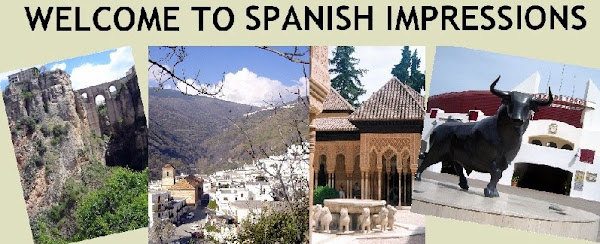The Plaza Mayor in Salamanca is considered to be the most beautiful square in Spain. It is just one of many 'must see' sights in this delightful city that has been dubbed "La Ciudad Dorada" - the Golden City.
 |
| part of the Plaza Mayor |
Perhaps it is the golden-brown weathering of the sandstone buildings that has led to this appellation - or perhaps it is because Salamanca is one of the most beautiful Renaissance cities in Europe. Certainly, the United Nations have recognised its exceptional cultural value by awarding Salamanca's old town World Heritage status.
Its location and glorious history have had an enormous influence on Salamanca's reputation as one of Spain's greatest historical and artistic cities. It is the capital of the province of Salamanca, one of the nine provinces of the autonomous community of Castile-Leon. Originally, Salamanca was part of the historic region of León. Conquering armies based themselves here because of the city's strategic position.
Salamanca was already an important Iberian settlement, when the Carthaginian general Hannibal occupied it in 217 BC. The town became a good base for the Romans because it was on the "Silver Road" from Astorga to Sevilla. They named the town Helmántica. The Visigoths followed and then the Moors - between the 8th and 11th centuries, Salamanca was situated right in the war zone during the conflicts between the Christians and the Moors. In 1102, the Christian forces of Alfonso VI reconquered the town. In 1178, King Ferdinand II of León set up his parliament in Salamanca. He also granted a charter of special privileges to the city, which was at that time the second most important in the kingdom. In 1218, King Alfonso IX founded Salamanca University - the first in Spain and one of the oldest in Europe. Salamanca was the main cultural centre of the Spanish Empire between the 15th and 18th centuries and the production of the first grammar of the Castilian language was formulated in the city during the 15th century. Saint Teresa of Ávila founded a Carmelite convent in the city in 1570. During the Peninsular War, Wellington captured the city and later, in the Spanish Civil War Franco took up residence in the Episcopal Palace. So, you see, Salamanca had an exceptional history and many famous people have been there!
 |
| Plaza de Aznay |
Salamanca has many monuments to its rich history. Perhaps a good place to start is in Plaza de Anay, which may not be quite as magnificent as the Plaza Mayor but which is surrounded by a few of the city's most prominent buildings. There is the Palacio de Anaya, one of a number of 16th century Renaissance palaces in the city; there is the University and also the New Cathedral. Salamanca's University was one of the greatest centres of learning in medieval times and Miguel de Cervantes and Hernán Cortés are just two of many famous Spaniards who studied there. Christopher Columbus lectured there. It is a pretty splendid building too, especially the façade facing the plaza.
 |
| University |
The New Cathedral is one of a pair, aptly named Catedral Nueva (new) and Catedral Vieja (old). They are physically connected to each other - the new one was begun in 1513 when it was decided that the old cathedral was too small. The Catedral Vieja was started in the 12th century in Romanesque style. It was completed a century later and one of its main attractions is its highly intricate 15th-century altar - the work of Nicolás Florentino. The Catedral Nueva was built in late Gothic style with Renaissance and Baroque decoration. Inside there are eighteen chapels but the Capilla Dorada is the best, housing as it does over a hundred sculptures.
 |
| Cathedral |
Opposite the southern facade of the Catedral Vieja is Casa Lis, which houses the Art Nouveau and Art Deco Museum. Only a short distance away is the River Tormes and the old Roman bridge. The other side of the river offers a splendid panoramic view of the town.
 |
| The Cathedral - view across the River Tomes |
 |
| a small part of the facades of the Plaza Mayor |
Of course, no visit to Salamanca would be complete without a visit to the Plaza Mayor. It is the social hub of the city and really quite splendid. At street level it is all arcades illuminated by lanterns. The arcaded buildings that surround the square are exquisitely decorated, especially the Royal Pavilion. Another building here is the Town Hall, which alone has more than eighty arches.
 |
| Casa de la Conchas |
The Casa de la Conchas is another attractive building. Hundreds of carved scallop shells, the symbol of the Order of Santiago, adorn the exterior of the house. The city has many mansions and palaces. There are also quite a number of churches and convents in Salamanca - reflecting the time when all the professors in the University were members of the clergy. The most notable temples are the 16th-century Dominican Convent and Church of San Esteban; the Convent of las Dueñas and the 17th-century Convent of the Augustinians that contains the "Immaculate Conception" by the artist José de Ribera.
 |
| Convento de San Esteban |
text extract from “Spanish Impressions” by Robert Bovington
ISBN 978-1-4452-2543-2 available from http://www.lulu.com/
photos - Robert Bovington Nov 2011

Hi Bob,
ReplyDeleteIt looks like your really enjoying exploring Spain.
Look forward to reading more articles on your travels.